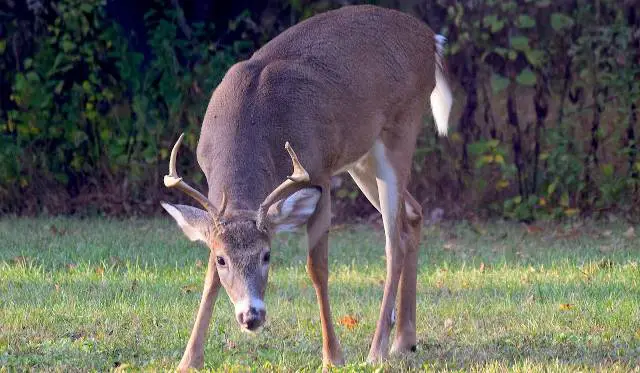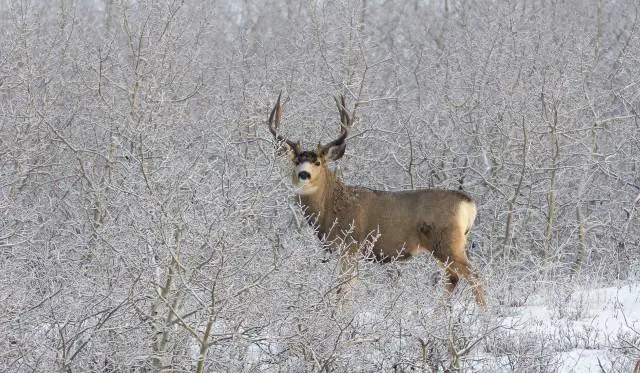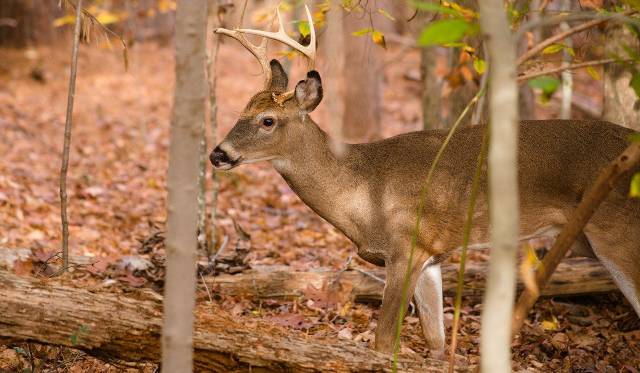The whitetail rut is a highly anticipated time of year for deer hunters, as it is the period when bucks become more active in their pursuit of does. This increased buck movement during the rut and unique behavioral patterns make bucks easier targets for hunters. To make the most of this hunting season, it’s essential to understand the rut, its phases, and how whitetail bucks behave during these times.

Contents
- Understanding the Rut
- Buck Behavior During the Rut
- Doe Influence on Buck Movement
- The Impact of Weather on Buck Movement
- Effects of Hunting Pressure on Buck Movement
- Buck Movement and Habitat
- Using Technology to Track Whitetail Bucks
- Research on Buck Movement
- Strategies for Hunting Rutting Bucks
- Frequently Asked Questions
- Related Articles:
Understanding the Rut
Phases of the Rut
There are several phases that make up the rut, each with unique characteristics and buck movement patterns. Improve your hunting success by being able predict buck behavior during pre-rut, peak-rut, and post-rut is advantageous.
Pre-Rut: Start of Breeding Season
The pre-rut is the beginning of the breeding season when bucks start showing interest in does, though most does are not yet receptive. During this phase, you might notice bucks establishing dominance by sparring with each other or rubbing their antlers on trees. This phase is typically marked by heightened deer activity and increased encounters with the older bucks around.
Pay attention to early signs of rutting activity like scrapes, rubs, and sparring, as these can help you identify the beginning of the rut period. This is also a good time to break out your rattling antlers to call in other male deer.
Seeking and Chasing
As the rut progresses, you’ll notice bucks becoming more aggressive in their pursuit of does. They devote most of their time and energy to seeking out and chasing estrus does.
During this phase, bucks can travel extensively, sometimes covering large distances in search of receptive mates. This unpredictable movement and seemingly single-minded focus on finding does create more opportunities for many hunters to intercept and harvest bucks.
Peak Rut
The peak rut is the climax of the breeding season, where the majority of does are in estrus and receptive to breeding. During this time, deer actively seek out does and spend a significant amount of time tending to them, which can lead to some fascinating interactions.
It’s not uncommon for a deer to become preoccupied with a specific doe, resulting in decreased caution and increased vulnerability to hunters.
Buck Behavior During the Rut
Mature Bucks Activity Patterns
During the rut, mature bucks become more active as they search for does to mate with. This period is characterized by a significant shift in their usual patterns since they tend to move more during daylight hours, especially at dawn and dusk.
Nocturnal Buck Movements
Even though bucks are more active during daylight in the rut, their nocturnal movement shouldn’t be underestimated. They still utilize the cover of darkness to search for does, which often increases their vulnerability to hunting strategies.
Core Areas and Excursions
During the rut, deer tend to expand their travel range beyond their usual core areas, making brief excursions into new territories in search of estrus does. This behavior can increase your chances of encountering bucks not typically found in your hunting area.
Doe Influence on Buck Movement
Estrous Cycles and Receptive Does
Does typically experience two to three estrous cycles per breeding season, each lasting around 24 to 48 hours. During this period, they become more interested in a mating opportunity, and their pheromones attract bucks.
You should be aware that whitetail buck can sense these pheromones from a long distance, which may cause them to travel outside of their usual home range. Their movement might increase significantly during this time.
Doe Groups and Focal Areas
Another factor influencing male deer movement is the presence of doe groups and focal areas. Focal areas are specific locations where does concentrate during the rut, and these spots can range between 60 to 140 acres in size. They are known to spend the majority of their time moving between these focal points.
When you’re planning your hunting strategies, it’s essential to pinpoint these areas on your hunting grounds and set up near the edges of these locations. This way, you will increase your chances of intersecting a mature buck as they travel between doe groups.
The Impact of Weather on Buck Movement
Rain
During the rut, rain can have varying effects on buck movement. Light rain may encourage some movement, as it helps to soften and muffle the sounds of deer walking through the woods.
In contrast, heavy rain can reduce male deer movement, as the deer may seek shelter to stay dry and avoid the harsh weather conditions. However, after a heavy rain, you may see an increase in deer activity, as the deer emerge to feed and replenish their energy.
Wind
Wind can play a significant role in how bucks move during the rut. In general, deer prefer to move when the wind provides cover for their movement. They are more likely to move upwind, where their scent can be picked up by does, and less likely to move when the wind is calm.
High winds can create noise and make it more difficult for deer to detect predators, so they may be less active. However, if the wind is consistent and not too strong, it may provide male deer with the cover they need to venture out in search of does.
Temperature
Temperature also affects deer movement during the rut. Deer are more active during cooler temperatures, as it’s more comfortable for them to move about in search of mates. When temperatures are too hot, deer may become less active, conserving their energy and avoiding excessive heat.
If temperatures drop significantly, deer may increase their feeding times and activity to maintain their energy levels and keep warm.
Snow
Heavy snow and blizzard conditions can cause deer to hunker down for multiple days, which can result in missed feedings and depleted energy reserves.
Once the severe weather has passed, deer will be more likely to venture out in search of food. Light snow, on the other hand, can aid in tracking and make deer movement more visible, making it easier for you to locate and pattern their activity.

Effects of Hunting Pressure on Buck Movement
Hunter Presence and Density
During the rut, buck movement can be significantly affected by hunting pressure. As more hunters enter the woods, deer become more cautious and may change their movement patterns to avoid detection.
As the hunting season progresses and hunting pressure increases, big bucks may become more nocturnal to avoid hunters.
- Increased hunting pressure: Higher density of hunters can lead to a decrease in daylight deer activity.
- More nocturnal behavior: Due to hunting pressure, deer may become more active at night and less visible during the day.
Adjusting Hunting Strategies
To successfully hunt pressured bucks during the rut, it is essential to adapt your hunting strategies. Here are some recommendations:
- Use low-impact approaches: Limit your disturbance in the woods, and be conscious of the noise you make while moving.
- Scout from a distance: Use binoculars or a spotting scope to locate deer from afar, avoiding intrusion into their core areas.
- Take advantage of weather conditions: Hunt on windy or rainy days to mask your noise, making it harder for deer to detect your presence.
- Target travel corridors: Focus on hunting areas that connect bedding and feeding destinations, as these are likely spots for buck movement.
Buck Movement and Habitat
Food Sources and Cover
During the rut, individual bucks focus primarily on finding does, but they still need to occasionally acquire resources like food and cover. A buck on the hunt may lose up to 25% of their body weight during the rut season as they are focused elsewhere
Natural food sources for deer include acorns, greenbrier, and other mast-producing trees. Agricultural fields, such as soybeans, corn, and alfalfa, can also be an attractant to deer.
You should also pay attention to the cover available in your hunting area. Deer often seek thickets and understory growth for resting or escape cover.
As a hunter, you should be aware of the location of the food sources in your hunting area. Bucks will move between these areas to gather resources when not actively pursuing does.
Water and Terrain
Deer still require water during the rut, so understanding the location of water sources can aid in predicting their movement. Check for creeks, ponds, and other water sources near your hunting area, or consider creating a small waterhole if no natural sources exist nearby.
Terrain plays a vital role in buck movement. Deer tend to travel along terrain features that provide natural funnels or pinch points such as saddles, ridges, or hillside benches. Bucks may use these features to cover ground more efficiently and to scent-check for does.
While hunting, familiarize yourself with the terrain in your area, and strategically position yourself near these natural funnels to increase your likelihood of encountering bucks.
Using Technology to Track Whitetail Bucks
Trail Cameras and Hunting Success
Trail cameras have become an essential tool for hunters to monitor deer activity in their hunting areas. They can provide crucial information about buck movement patterns, including when they are most active and which routes they frequently use.
By strategically placing your deer cameras, you can gather valuable data that will help you predict when and where bucks are more likely to be present.
Some helpful tips for using deer cameras during the rut include:
- Place them near known buck bedding areas, travel corridors, and food sources
- Check the cameras frequently, but avoid disturbing the area too much
- Analyze the collected images to identify patterns in buck movement, and adjust your hunting strategy accordingly
Research on Buck Movement
GPS Collars and Tracking Studies
GPS collar technology has made significant advancements in recent years, allowing for better accuracy in data collection and providing new insights into buck behavior during the rut. By fitting bucks with GPS radio collars, researchers have been able to track collared bucks and develop a better understanding of their habits and patterns during this crucial period.
Caesar Kleberg Wildlife Research Institute
A study conducted by the Caesar Kleberg Wildlife Research Institute involved capturing bucks, attaching GPS collars to them, and tracking their movements over a five-year period every hour from November to February.
This research provided valuable information on how bucks travel and interact with their environment during the rut. From the data gathered, it has been observed that mature bucks tend to:
- Increase their rate of movement during the rut
- Utilize a smaller area of their summer home range as does decrease their movement rates
Mississippi Statue University
Mississippi Statue University conducted a study of buck movement. According to this collaborative study, mature bucks in Mississippi travel about 1,500 yards daily in October, with distances peaking during the early rut at just over 2,000 yards.
Strategies for Hunting Rutting Bucks
Scouting and Trail Patterns
During the rut, movement increases significantly as they search for and pursue estrus does. Begin your hunt by thoroughly scouting the area where you plan to hunt. Look for signs of activity, such as rubs, scrapes, and heavily used trails.
Keep in mind that these trails may be different from those used during other seasons, as bucks are focused on locating does during rutting. Pay particular attention to overgrown fields or remote areas, as bucks will often push estrus does away from potential rivals.
Utilize trail cams to monitor movement patterns. This will give you a better understanding of when and where bucks are most active, allowing you to focus your hunting efforts on prime locations.
Stand Placement and Timing
As the rut progresses, male whitetail deer are more likely to be on the move and less cautious about exposing themselves. Take advantage of these vulnerabilities by setting up your stand or blind in strategic locations, such as pinch points or funnels, which are natural travel corridors for deer movement.
Be prepared for quick, long-range shooting opportunities, as rutting bucks often move quickly and cover a lot of ground.
Timing your hunt can play a crucial role in your success. Key periods during the rut to target include pre-rut short-range cruising bursts, which occur during the last week of October in northern states and the first week of November in southern states.

Frequently Asked Questions
What time of day do bucks move during the rut?
Early morning and late afternoon hours are typically the most active periods. However, during the rut, bucks move at various times for longer periods of the day.
Do bucks move all day during the rut?
Yes, bucks can move all day during the rut, especially when searching for receptive does. While they tend to be more active during early morning and late afternoon, you may still spot them during midday, particularly if rut activity is high.
How far will a buck travel during the rut?
The distance a buck travels during the rut can vary, but research suggests that they may move several miles from their core area in search of receptive does. While some bucks have been observed roaming repeatedly over large distances, others may have more localized ranges.
Should you hunt all day during the rut?
Yes, hunting all day during the rut can be a highly effective strategy. As bucks are frequently searching for does and traveling greater distances, they may be moving and visible atypical times of the day. Staying in the stand or blind all day increases your chances of encountering a buck on the move.
What factors influence buck movement during the rut?
Key factors include weather, wind, hunting pressure, and habitat. For example, wind plays an important role, with significant changes being a major deer movement trigger.
How can hunters predict buck movement patterns during the rut?
Predicting buck activity during the rut involves understanding factors that influence their behavior, such as changes in the wind, moon phase, hunting pressure, season, and local habitat. Analyzing past movement patterns on deer cameras or through scouting can help you identify and anticipate buck travel patterns.
